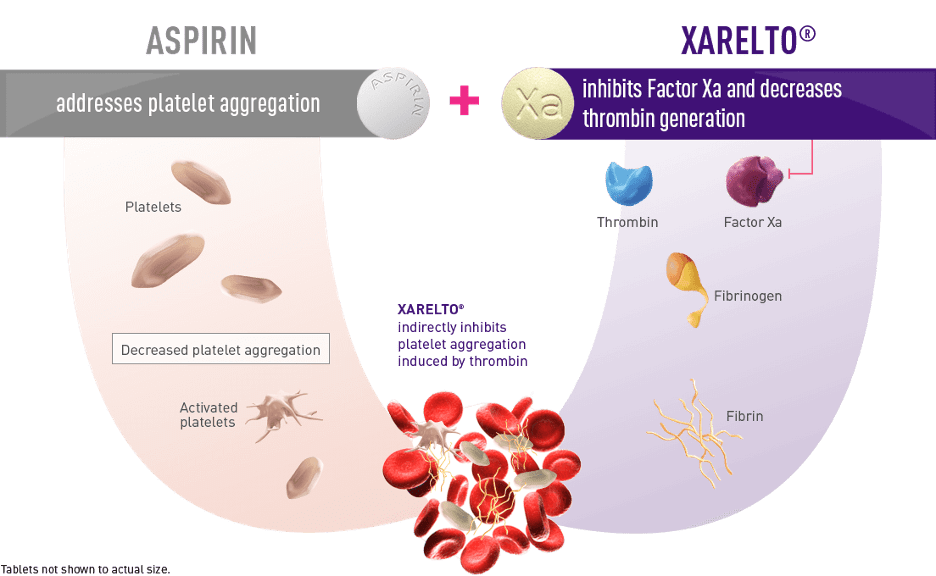Table of Contents
I. Xarelto: Definition and Uses
II. Xarelto’s Mechanism of Action
III. Xarelto: Medication Safety and Side Effects
IV. Accessing Xarelto Affordably
Xarelto (generic name rivaroxaban) is a medication critical for the prevention and treatment of blood clots, a common yet life-threatening condition. Since its first approval in 2011, Xarelto has revolutionized the approach to managing blood clot-related disorders such as deep vein thrombosis (DVT), pulmonary embolism (PE), and atrial fibrillation.
Its significance is underscored by its ability to offer a safer, more effective alternative to traditional blood thinners, making Xarelto a welcome medication from patient and provider perspectives alike.
In this article, we’ll provide a comprehensive guide on Xarelto, including its uses, mechanism of action, safety profile, potential side effects, and options for affordable access. Whether you’re considering starting Xarelto, seeking to better understand its impact, or exploring more cost-effective ways to fill your Xarelto prescription, this guide is for you.
Quick Takeaways:
- Xarelto is essential for preventing life-threatening blood clots, including deep vein thrombosis (DVT), pulmonary embolism (PE), and strokes.
- Its mechanism of action involves directly targeting and neutralizing Factor Xa, inhibiting thrombin production to prevent clot formation.
- Xarelto offers benefits such as once-daily dosing, predictable anticoagulant effects, and suitability for diverse patient populations.
- Side effects of Xarelto may include gastrointestinal issues, increased bleeding risk, and allergic reactions, requiring careful monitoring and medical attention if symptoms arise.
- Canadian pharmacies provide a cost-effective option for obtaining Xarelto, offering lower prices compared to U.S. pharmacies, with safe and legal options for online ordering.
Xarelto: Definition and Uses
Xarelto is a blood thinner medication that plays a crucial role in the medical management of blood clots and prevention of stroke. It’s specifically designed to treat or prevent venous thromboembolism (VTE), a very serious condition which can manifest in the form of:
- Deep vein thrombosis: When blood clots form in the deep veins, typically in the legs
- Pulmonary embolism: When a clot travels to the lungs, blocking blood flow
- Superficial vein thrombosis: Formation of blood clots in veins close to the skin's surface, often causing pain and inflammation

In addition to its role in managing VTE, Xarelto is instrumental in preventing strokes and serious blood clots in individuals with atrial fibrillation not caused by heart valve disease. AFib increases the risk of clots forming in the heart, which can travel to the brain and cause a stroke. By mitigating this risk, Xarelto provides a protective measure against potentially fatal outcomes.
Xarelto is often prescribed to prevent DVT and PE in adults undergoing hip or knee replacement surgery, recognizing the heightened risk of clots in patients immobilized during post-surgical recovery. It’s also used alongside aspirin to lower the risk of heart attack and stroke in adults with coronary artery disease or peripheral arterial disease, conditions characterized by narrowed or blocked blood vessels.
For children and certain infants who have undergone at least 5 days of initial anticoagulation treatment, Xarelto is approved to treat and prevent the recurrence of DVT and PE. This extends its application to a younger demographic, showcasing its versatility and importance across various age groups in preventing and managing clot-related disorders.
Xarelto’s Mechanism of Action
Xarelto falls under a class of medications called Factor Xa inhibitors, which directly target and neutralize Factor Xa without the need for a cofactor such as antithrombin. This direct inhibition halts production of thrombin, a protein necessary for clot formation, thereby preventing clots from developing and growing.

This targeted approach allows for effective clot prevention and treatment while offering the benefit of not requiring routine blood monitoring, a significant advancement over older anticoagulants. In addition, Xarelto offers a range of other benefits that make it a preferred choice for patients and providers:
- Convenient once-daily dosing regimen reduces medication adherence burden
- Demonstrated efficacy in preventing stroke, systemic embolism, DVT, PE, and recurrent DVT/PE
- Predictable anticoagulant effect eliminates the need for routine monitoring and dose adjustments
- Suitable for diverse patient populations, including those with renal impairment, without dose modifications
- Favorable safety profile with lower risk of major bleeding events compared to warfarin
In summary, Xarelto's targeted inhibition of Factor Xa represents a significant advancement in anticoagulant therapy, providing effective prevention and treatment of thrombotic events without the need for frequent monitoring.
Its multifaceted benefits underscore its importance in clinical practice, offering patients and healthcare providers a reliable and well-tolerated option for managing thrombotic disorders.
Xarelto: Medication Safety and Side Effects
Xarelto is generally well-tolerated, but as with any medication, it can lead to certain side effects that patients must be aware of. Commonly reported side effects include gastrointestinal issues such as nausea and indigestion, as well as increased bruising or bleeding tendencies. These effects are usually mild to moderate and tend to diminish over time.
More serious risks include the elevated chance of bleeding, including internal bleeding, which can be severe or life-threatening. Other serious side effects may include allergic reactions, liver complications, and reduced platelet counts.
Additionally, Xarelto may not be suitable for individuals with specific medical conditions, such as severe liver or kidney disease, or those at a high risk of bleeding due to recent surgery or injury.
Patients should remain vigilant for signs of bleeding, such as unusual bruising, blood in urine or stool, or prolonged bleeding from cuts or wounds. Seeking immediate medical attention is imperative if any of these symptoms occur, as timely intervention can mitigate complications. Furthermore, patients should disclose all medications or supplements to their healthcare provider as they may interact with Xarelto, heightening the risk of bleeding or other adverse effects.
Regular communication with healthcare providers and vigilant monitoring for adverse reactions are essential for safe and effective use of Xarelto in preventing and treating thrombotic disorders.
Accessing Xarelto Affordably
Canadian pharmacies offer a cost-effective solution for obtaining medications like Xarelto. Different pricing regulations and currency exchange rates in Canada vs. the United States mean Xarelto costs are often lower in Canada compared to the U.S.
Ordering Canadian medications is safe and legal for medications like Xarelto that are FDA approved, and strict safety standards from Health Canada and the Canadian International Pharmacy Association (CIPA) ensure the medication you receive is safely manufactured, sourced, and sent directly to your home.
Learn more here about saving on your next Xarelto prescription at My Drug Center.
The information in the article is not meant to be used for treatment or diagnosis. It is designed for general awareness and for information purposes only. Always consult a medical professional for your specific healthcare needs.
